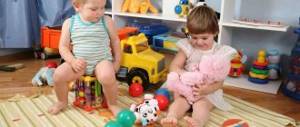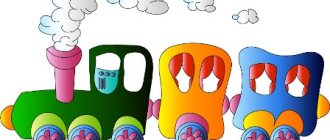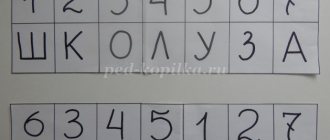Circles of Lull "Musical Professions"
Author: Tatyana Belan
An educational logic game for preschool children, Llull circles “Musical Professions” is aimed at consolidating knowledge about the professions of a musician, musical instruments, expanding their horizons and vocabulary on this topic. Classes with this manual develop attention, imaginative and logical thinking, and semantic memory.
The material is provided in electronic form - a compressed archive file for downloading and printing yourself.
This manual consists of: 1. 2 A4 sheets with templates for the game. 2. Rules of the game.
You can watch a master class on assembling the manual here. Preparing for the game: 1. Print the game materials on a color printer on thick paper, cut out the templates and laminate. 2. Align the 2 circles with pictures and the pointer with each other using a connecting piece. Progress of the game: the teacher invites children to look at pictures depicting musicians and musical instruments depicted in sectors of a large and small circle. Then he sets the pointer sector opposite any picture of a large circle and names a word, for example: baton, microphone, piano, saxophone, etc. The music director asks the question: “Who owns this item?” By turning a small circle depicting the profession of a musician, the child combines the sector that corresponds to a given object or musical instrument based on its characteristic features and names the profession of a musician. The game continues until the child matches all the paired pictures. Pictures-pairs: 1. Conductor's baton - conductor 2. Microphone - singer 3. Piano - pianist 4. Drums - drummer 5. Trumpet - trumpeter 6. Violin - violinist 7. Saxophone - saxophonist 8. Guitar - guitarist.
The materials are sent to your email in the form of a compressed folder (WinRAR Archive) for downloading, printing and assembling the layout yourself.
- Delivery of materials is carried out automatically within a few minutes after payment to your email address specified when placing an order.
- If the letter is not in your inbox, please check your spam folder.
- When filling out the order form, please make sure your e-mail address is correct!
COST OF LAYOUTS — 40 rubles
After clicking the button, you will be taken to the product page in Robo.market
Payment is made through the Robokassa
via a secure protocol. You can choose any convenient payment method.
Before purchasing, please read the terms of supply of materials and answers to frequently asked questions
How to place and pay for an order
Protected by copyright law.
Copying, transfer to third parties, posting on the Internet,
and commercial use of site materials is strictly PROHIBITED.
Summary of a music lesson for older children “Who is called a musician?”
Lesson summary "Profession - musician"
Direct educational activities
"Cognitive Development"
Middle-senior group
Topic: “ Profession Musician ”
Goal: “Cognitive development”
: Introduce children to
the profession and activities of a musician
.
To promote the accumulation in children of specific ideas about people’s professions
related to creativity:
musician
, singer, dancer, composer.
To consolidate children’s previously acquired knowledge about the properties of musical sound
, based on the material studied, the name and sound
of musical instruments
.
"Artistic and aesthetic development"
:
Introduce children to musical culture
.
Improve skills in playing musical instruments
.
To cultivate artistic and aesthetic taste.
Improve your dance moves.
Develop dance and play creativity.
"Social and communicative development"
: Develop curiosity, imagination, ability to interact with peers;
Develop the ability to listen to the speech of an adult and each other.
"Speech development"
: Enrich children's speech with words: notes,
musical instrument
, orchestra, composer; activate the names of instruments in children’s speech;
Develop the articulatory apparatus.
Physical development: Formation of correct posture. Development and improvement of motor skills.
Form of delivery: music-themed lesson
.
Integration of areas: cognitive development, speech development, artistic and aesthetic development, communicative and personal, physical development.
Methodological techniques: visual and game methods in combination with verbal ones, conversation, appeal. Questions for children and assignments, explanations, instructions, reminders, assessment of children's activities. Use of ICT (presentation, change of activities.
Material: projector, laptop, dance costumes, watering can, musical instruments
(spoons, pipe for a surprise moment.
Vocabulary enrichment: musician
, composer, singer (vocalist, dancer, violinist, violin, flute.
Preliminary work: Learning the dance composition “Magic Flower”
, playing spoons
“Village Spoons”
, learning the song
“Pea”
- stepwise movement of the melody.
Progress of the lesson:
1. Organizational point:
To the march of the muses. L. Parlova children enter the music room
, greet the guests
(singing the greeting)
and sit on chairs in front of the screen.
2. Main part:
Educator: Today we will talk about professions
.
There are many professions in the world
.
And they are all very different and at the same time very necessary for us. When you grow up, you will also choose a profession
.
My profession is
“
musician.
” Why do you think it is called that?
(answers: because it is connected with music, etc. )
And so, pay attention to the screen, who are the musicians
.
Showing a presentation about musicians
.
Many people love music
, some do it, and a select few are given the talent
of a musician
.
musicians
not only those who play any
musical instrument
, but also vocalists (singers, composers, people who write, compose
music
, dancers. In principle,
music
can be called a musician .
Musician's profession
music
itself .
With the advent of the first musical
instruments and the first
musicians
.
A good musician is one
who not only
professionally
composes or performs
musical works
.
This is a person who knows how to express thoughts and ideas through music
, convey moods, and evoke emotions.
Musicians
can be amateurs or
professionals
.
The first ones make music for the soul
, for themselves or a narrow circle of people.
Professional musicians make their living from music
.
And so, guys, we found out who the musicians
.
What do you think, can we consider ourselves musicians
?
We sing? Shall we dance? Do we play instruments? (Children's answers)
Of course, we can be musicians
.
So let's try ourselves as musicians
.
3. Practical part:
Let's start with the chant: “Pea”
(children perform the song showing the progressive movement of the melody.)
And now the spoon boys will perform the composition “Village Spoons”
(children play along on spoons to Z. I. Root’s song
“Village Spoons”
)
Now I propose to play the didactic game “Remove the unnecessary things that do not apply to music "
(game principle: pictures of musical instruments
, pipe, accordion and chair, children name the extra picture, then pictures of a singer playing an instrument and a doctor, children remove the extra picture).
Educator: guys, I suggest you get up and rest a little.
Fizminutka: We played musicians
,
(spring)
Sang songs, danced (tilts to the right, left)
We played on spoons (claps)
And a little tired. (breathing exercise)
Well, to complete our transformation into musicians
I suggest to the dancers.
Children perform musically
-art composition
“Magic Flower”
.
4. Summary of the lesson
.
Guys, what new did you learn in this lesson
?
(children's answers)
Yes, we got acquainted with the profession of a musician
.
Let's clarify once again who is called musicians
?
(children's answers)
Correct: dancers, composers, singers, people whose activities are related to music
.
I really liked the way you presented the profession of a musician
.
I want to give you this musical instrument
, a flute.
Perhaps some of you, when you grow up, will choose such a wonderful, creative profession
.
Self-analysis of educational activities on cognitive development in the middle group on the topic “ Profession Musician ”
“ Profession of a musician ” were presented to your attention.
using ICT
(presentation)
.
Class
compiled taking into account program requirements, age characteristics and the level of knowledge and skills of children of this age.
In accordance with the requirements of the Federal State Educational Standard, joint activities took place in the integration of the following areas: cognitive development, social and communicative, speech, artistic and aesthetic, physical.
Thus, 5 educational areas were used in integration.
The following goals were set:
"Cognitive Development"
: Introduce children to
the profession and activities of a musician
.
To promote the accumulation in children of specific ideas about people’s professions
related to creativity:
musician
, singer, dancer, composer.
To consolidate children’s previously acquired knowledge about the properties of musical sound
, based on the material studied, the name and sound
of musical instruments
.
"Artistic and aesthetic development"
:
Introduce children to musical culture
.
To cultivate artistic and aesthetic taste.
Practice pure singing of the progressive movement of the melody, in clear diction.
Improve your dance moves.
Develop dance and play creativity.
Improve skills in playing musical instruments
.
Foster activity, initiative, and independence.
"Social and communicative development"
: Develop curiosity, imagination, ability to interact with peers;
Develop the ability to listen to the speech of an adult and each other.
"Speech development"
: Enrich children's speech with words: notes,
musical instrument
, orchestra, composer; activate the names of instruments in children’s speech;
Develop the articulatory apparatus.
Physical development: Formation of correct posture. Development and improvement of motor skills.
To solve these problems, the following equipment was used:
Projector, laptop, dance costumes, watering can, musical instruments
(spoons, pipe for a surprise moment.
Preliminary work was carried out:
Musical music was selected
The material is age-appropriate, understandable and accessible to children.
Learning the dance composition “Magic Flower”
, playing spoons
“Village Spoons”
, learning the song
“Pea”
- stepwise movement of the melody.
In my work I used methods such as: gaming, visual, verbal, practical, which reflected the same topic and were interrelated.
These methods contributed to the development of children's independence and allowed them to concentrate their attention on completing tasks.
The organizational aspect was aimed at developing communicative qualities, establishing friendly relationships both within the children's team and between the teacher and the children. Also for the development of musical and rhythmic hearing
, development of singing skills.
The placement and use of aids was rational, well thought out in the learning space and in the lesson
.
Lesson duration
corresponds to the norms for children of this age - 20 minutes.
The lesson is dynamic
, it includes five techniques that provide for a quick change of activity.
The rotation of techniques during the lesson
made it possible to avoid fatigue of the children.
Class
passed through the main types
of musical
activities such as singing,
musical
and rhythmic movements, and playing instruments.
All moments of the lesson
logical and consistent, subordinated to one topic.
In this joint activity, I tried to build a person-oriented interaction with children: listen to the answers of each child, create a situation of success for each child. There was a cooperative relationship between me and the students. When planning joint activities, I took into account the sequence, dosage, time allotted for the lesson
taking into account this age.
The children showed interest and activity in joint activities, answered questions posed, completed all tasks, heard the teacher, and worked at a given pace. The children responded emotionally to the tasks and completed them with interest. During the lesson,
children's behavior skills were practiced (the ability to listen to the answers of others, listen carefully to assignments, etc., the children's behavior during
the lesson
was regulated and directed, and the children maintained interest in
the lesson
throughout the entire time.
Lesson summary
was organized in the form of a conversation, consolidating the knowledge gained in
class
.
I also used a surprise moment, the presentation of a musical instrument
, a flute.
Thus, I believe that in the course of the joint activities, the set goals were achieved and a certain result was visible.
4
Drawing lesson on the topic “Professions” in senior groups
Often, drawing classes are held in different groups in kindergartens. And each such lesson is devoted to a specific topic: family, this or that time of year, holidays. But children are also given the task of drawing themselves in the future: what profession they see themselves in.
Fine arts lesson on the topic “Professions” in the senior group of kindergarten
Especially for such classes, the teacher draws up a GCD summary. It includes the goals, objectives of the lesson, methods, attributes that will be required, short artistic works related to the profession that the teacher can read while drawing or after, the stages of the lesson.
Drawing lesson in kindergartens
The main thing is that the activity brings a lot of benefits and new information to the children.
Lesson Objectives
In order for drawing in the senior group on the topic “Professions” to be useful, it is necessary to set and realize an important goal of the lesson: to teach children to draw a person in a plot context.
That is, you cannot simply draw a human figure on a white background. It is necessary that there is something in the background (for example, transport or a building), there is some kind of action, movement.
This point needs to be explained to children in more detail.
Important! They must learn what composition is, what it is built from, what foreground and background are, and how to reproduce movement in a drawing.
In this case, several types of activities will interact with each other:
- developing;
- educational;
- gaming;
- productive;
- perception of works of art.
The teacher needs to set several priority tasks that must be completed during the lesson:
- teach children to draw people who are in motion;
- talk about composition and teach how to create it;
- give children new knowledge about types of profession;
- watch how the children create the composition of their drawing (it should be located across the entire sheet of paper).
He also needs to focus on two main tasks:
- educational - throughout the entire lesson, the teacher explains to the children why it is so important to respect other people’s work and all work in general, why there are no bad professions, to form a positive attitude towards work, towards drawing, and teach them to work in a team. The teacher needs to explain to the children why work must be approached with responsibility and desire;
- developmental - this task is aimed at developing fine motor skills of children’s fingers, developing imagination, memory and logical reasoning;
- There is a third important task that cannot but be included in the lesson plan - educational. It is aimed at studying the techniques of fine art, drawing techniques, and replenishing vocabulary. The teacher must demonstrate to children how to properly hold a brush and apply strokes, and draw children’s attention to the external features of a particular professional activity (for example, the uniform and the colors that predominate in it).
Materials and equipment needed for the lesson
The availability of certain tools will depend on the structure of the lesson. For example, if it is dedicated to drawing with paints, then you will need paints, brushes, paper, jars filled with water, rags, pictures on which representatives of various professional activities will be drawn.
How and when to instill a love of reading in children, ways to interest them
If the lesson is devoted to drawing with pencils or felt-tip pens, then you will need pencils, paper, felt-tip pens, and so on.
Important! You can bring illustrations for clarity, or turn on the projector and show a short presentation with pictures to better assimilate the material.
The teacher will also need a book with poems or songs to read literature during class. If he wants to diversify the lesson, he can call his parents.
Firstly, then you can devote the main part of the lesson to the interaction between children and parents, act out a short scene, ask a few questions to both children and their parents.
Or organize a small performance: call a fairy-tale hero with whom the children would engage in a dialogue on the topic of profession.
Children in the process of drawing
Preliminary work with children, discussion of the topic
Before drawing on the topic “Professions” begins in kindergarten in the senior group, children need to be asked several thematic questions, to which they should answer not with short answers, but with more capacious, detailed ones. First, you need to list what types of positions there are for men and women.
Men's
- firefighter;
- sailor;
- driver, truck driver;
- pilot;
- blacksmith;
- a carpenter;
- electrician;
- military;
- astronaut.
Women's
- educator;
- teacher;
- housewife;
- doctor;
- nanny;
- salesman;
- conductor;
- hairdresser;
- fashion model;
- cosmetologist
And many other areas of activity.
Next, children are asked the question: what do they dream of becoming in the future? Everyone takes turns answering it.
Talking and sitting for long periods of time tires children and they need to burn off some energy. To cheer up the children, a short physical education session is held. It consists of the following exercises:
- head nods;
- head rotation;
- put your hands in a “lock” and twist;
- jump a little;
- extend your arms forward and shake.
To make it more fun, you can turn on music or warm up to children's songs, which are intended for small physical exercises.
A teacher shows children exercises during physical education.
Practical part of the lesson, drawing a “profession”
In order for the drawing of a profession to be useful in the older group, and for the children to find it interesting, the teacher needs to adhere to a certain course.
- First, he needs to find poems that are dedicated to professions and drawing. At the end, the teacher needs to ask the children the question: “What professions can you name?” However, they should not name those that have already been voiced in the poem.
- Next you need to organize a simple game. The teacher takes the ball, throws it, the one who catches it guesses a riddle related to human activity. Or you can show children pictures so that they visually understand who is depicted in the picture by profession. At the end, the teacher must praise the children.
- The third stage will be the drawing itself. The teacher once again shows pictures of people so that the children can understand what they look like and how their torso and arms are positioned. It is necessary that the teacher draw the children’s attention to all the depicted details.
Everything about preparing children for school on your own
Note! Children will need to understand what colors are required to be used for a particular profession (for example, red will be the dominant color for firefighters). And what's the best way to mix colors to create a nude or pinkish tint for the skin.
The guys start drawing, the teacher does not forget to observe and help those who ask for help.
Drawing steps:
- the teacher explains how to draw the foreground and background;
- what colors may predominate in a particular profession;
- shows the technique of drawing people;
- Based on all that has been said, he invites the guys to try to draw themselves in the profession in which he sees himself.
Note! At the end, she praises the children and their drawings and suggests using them to put together an album called “What I want to become in the future.”
The same technique can also be used in a drawing lesson, but in a preparatory group on the topic “Professions” in kindergarten.
To make drawing more fun for the children, you can play music quietly in the background, or the teacher can sing a few songs dedicated to this topic.
Important! Teachers can arrange a joint lesson with parents. Children will feel more confident, they will have an incentive to show everything they are capable of, and adults will be able to see what their child wants to do in the future, as well as discern their professional characteristics.
Joint activities will also help parents and children get even closer, learn to interact and understand each other.






